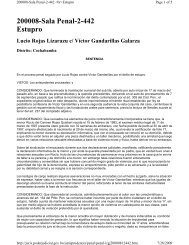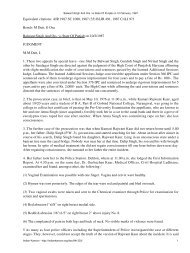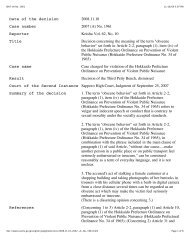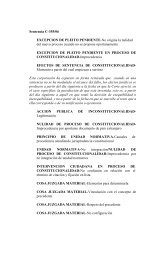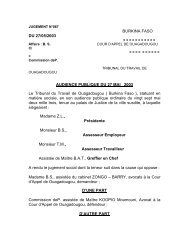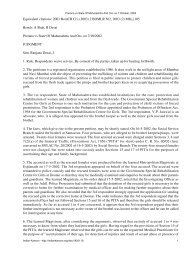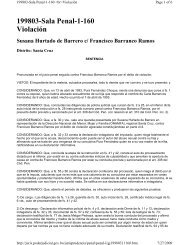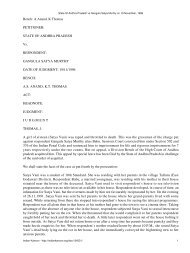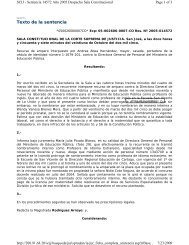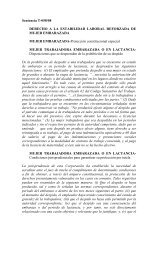P. Rathinam v. Union of India - Cornell University
P. Rathinam v. Union of India - Cornell University
P. Rathinam v. Union of India - Cornell University
- No tags were found...
Create successful ePaper yourself
Turn your PDF publications into a flip-book with our unique Google optimized e-Paper software.
is to reach the soul to stir it to make it cease to be cruel. Let us humanise our laws. It is never late to do so.75. Suicide, as has already been noted, is a psychiatric problem and not a manifestation <strong>of</strong> criminal instinct.We are in agreement with Dr (Mrs) Dastoor that suicide is really a "call for help" to which we shall add thatthere is no "call for punishment" in it. Mention may also be made about what was observed in "The Attitudes<strong>of</strong> Society towards Suicide", a xerox copy <strong>of</strong> which is a part <strong>of</strong> written submissions filed on behalf <strong>of</strong>Respondent 2 (State <strong>of</strong> Orissa) in W.P. No. (Crl.) 419 <strong>of</strong> 1987. It has been stated in this article at p. 9 thatshortly after passing <strong>of</strong> the Suicide Act, 1961 (in England), the Ministry <strong>of</strong> Health issued recommendationadvising all doctors and authorities that attempted suicide was to be regarded as a "medical and socialproblem", as to which it was stated that the same was "more in keeping with present-day knowledge andsentiment than the purely moralistic and punitive reaction expressed in the old law".76. So what is needed to take care <strong>of</strong> suicide-prone persons are s<strong>of</strong>t words and wise counselling (<strong>of</strong> apsychiatrist) and not stony dealing by a jailor following harsh treatment meted out by a heartless prosecutor.(9) Is suicide a non-religious act?77. Every individual enjoys freedom <strong>of</strong> religion under our Constitution, vide Article 25. In a paper which ShriG.P. Tripathi had presented at the World Congress on Law and Medicine held at New Delhi under the caption"Right to die", he stated that every man lives to accomplish four objectives <strong>of</strong> life: (1) Dharma (religion andmoral virtues); (2) Artha (wealth); (3) Kama (love or desire); and (4) Moksha (spiritual enjoyment). All theseobjectives were said to be earthly, whereas others are to be accomplished beyond life. When the earthlyobjectives are complete, religion would require a person not to cling to the body. Shri Tripathi stated that aman has moral right to terminate his life, because death is simply changing the old body into a new one by theprocess known as Kayakalp, a therapy for rejuvenation.78. Ins<strong>of</strong>ar as Christians are concerned, reference may be made to what Pope John Paul 11 stated when hegave his approval to the document issued by the sacred congregation stating:when inevitably death is imminent in spite <strong>of</strong> the means used, it is permitted in conscience to take decision torefuse forms <strong>of</strong> treatment that would only secure precarious and burdensome prolongation <strong>of</strong> life, so long asthe normal care due to sick person in similar cases is not interrupted......79. In the Encyclopaedia <strong>of</strong> Religion, Vol. 8 (1987), mention has been made at pp. 541 to 547 as to how "life"has been understood by different421P.<strong>Rathinam</strong> vs <strong>Union</strong> Of <strong>India</strong> on 26 April, 1994religions. After discussing the subject as understood by the primitive societies, Judaism, Christianity,Hinduism and Buddhism, the discussion has been included by stating that the very act <strong>of</strong> posing the question"What is life?" produces an initial sense <strong>of</strong> bafflement and perplexity. It has been stated thereafter that aprecise, distinct and universally acceptable concept does not accompany the use <strong>of</strong> the word "life"; and thatposing <strong>of</strong> the above query brings in its wake a sense that life is an "inexhaustible storehouse <strong>of</strong> mysteries, arealm <strong>of</strong> endlessly self-perpetuating novelties, in which the solution to any given problem gives rise to aplethora <strong>of</strong> other questions that beckon the always restless, never contended mind <strong>of</strong> Homo Sapiens to seekfurther for additional answers or, at least, to search out more intellectually refined, morally elevating, andspiritually salutary ways <strong>of</strong> pursuing the quest". So, life does not end in this world and the quest continues,may be after the end <strong>of</strong> this life. Therefore, one who takes life may not really be taken to have put an end tohis whole life. There is thus nothing against religion in what he does.80. Ins<strong>of</strong>ar as our country is concerned, mythology says Lord Rama and his brothers took Jalasamadhi in riverSaryu near Ayodhya; ancient history says Buddha and Mahavira achieved death by seeking it; modem history<strong>India</strong>n Kanoon - http://indiankanoon.org/doc/542988/ 17



